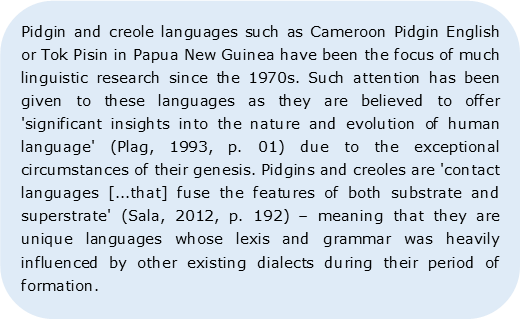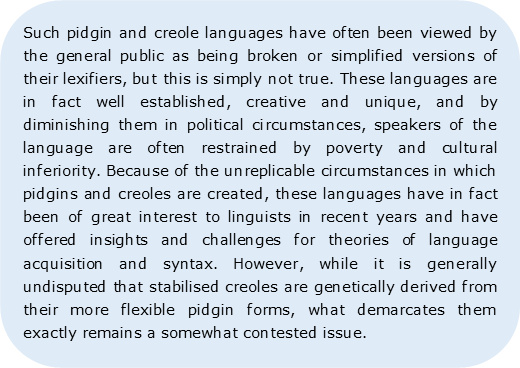Does academic English use all 5 phrase functions?

This is the second and final chapter about Phrase Functions. To complete this reader, read each chapter carefully and then unlock and complete our materials to check your understanding.
– Review the five phrase functions in English
– Provide authentic example paragraphs for analysis
– See in an authentic setting how subjects, objects, predicators, adverbials and complements are used
Chapter 2
In this second and final chapter on phrase functions, we look specifically at how each function (subject, object, predicator, adverbial and complement) is used in academic contexts. To demonstrate the frequency of these five functions in academic writing, we’ve included the first three paragraphs from our example Cameroon Pidgin English essay below. In each of these paragraphs, the phrase functions are labelled in [square brackets] and the clause boundaries are marked using //double slashes//. When reading, notice how common the subject-complement structure is in EAP, how frequently adverbials are employed, and how many sentences are composed of multiple clauses.


// Pidgin and creole languages such as Cameroon Pidgin English or Tok Pisin in Papua New Guinea [subject] have been [predicator] the focus of much linguistic research [complement] since the 1970s [adverbial] //. // Such attention [subject] has been given [predicator] to these languages [object] // as [adverbial] they [subject] are believed to offer [predicator] ‘significant insights [object] into the nature and evolution of human language’ [adverbial] (Plag, 1993, p. 01) due to the exceptional circumstances of their genesis [adverbial] //. // Pidgins and creoles [subject] are [predicator] ‘contact languages [complement] // that [subject] fuse [predicator] the features [object] of both substrate and superstrate’ [adverbial] (Sala, 2012, p. 192) // meaning [predicate] that [adverbial] they [subject] are [predicator] unique languages [complement] // whose lexis and grammar [subject] was heavily influenced [predicator] by other existing dialects [adverbial] during their period of formation [adverbial] //.

// Pidgin and creole languages [subject] developed [predicator] most commonly [adverbial] during the Atlantic slave trade [adverbial] between the 15th and 19th centuries [adverbial] // when [adverbial] slaves without a common tongue [subject] were forced [predicate] // into [adverbial] situations [subject] requiring [predicator] communication [object] by their European, imperial owners [adverbial] //. // Colonial languages such as English, French and Portuguese [subject] are [predicator] therefore [adverbial] the most frequent superstrata [complement], // with [adverbial] languages such as Arabic and Malay [subject] also [adverbial] having acted [predicator] as [adverbial] lexifiers [complement] in more isolated cases [adverbial] (Michaelis et al., 2013) //. // The substrate languages that provided much of a pidgin and creole’s grammar [subject] are [predicator] however [adverbial] often [adverbial] more difficult to determine [complement] //. // As [adverbial] West Africa [subject] was [predicator] the principal target of slavers [complement] between the 15th and 19th centuries [adverbial] (Holm, 2000), // many substrata [subject] are believed to be [predicator] from the abundant Niger-Congo language family [complement] (Williamson and Blench, 2000) //. // With as many as 2,000 languages [adverbial], this region [subject] is [predicator] however [adverbial] linguistically heterogeneous [complement], // making [predicator] it [subject] exceptionally difficult [complement] to say [predicator] for certain [adverbial] // which language or languages [subject] may have acted [predicator] as [adverbial] the original substrata [complement] //.

// Such pidgin and creole languages [subject] have often been viewed [predicator] by the general public [adverbial] as [adverbial] being [predicator] broken or simplified versions of their lexifiers [complement], // but [adverbial] this [subject] is [predicator] simply [adverbial] not true [complement] //. // These languages [subject] are [predicator] in fact [adverbial] well established, creative and unique [complement], // and [adverbial] by [adverbial] diminishing [predicator] them [object] in political circumstances [adverbial], // speakers of the language [subject] are [predicator] often [adverbial] restrained [complement] by poverty and cultural inferiority [adverbial] //. // Because of [adverbial] the unreplicable circumstances [complement] in which [adverbial] pidgins and creoles [subject] are created [predicator], // these languages [subject] have [predicator] in fact [adverbial] been [predicator] of great interest to linguists [complement] in recent years [adverbial] and [adverbial] have offered [predicator] insights and challenges [object] for theories of language acquisition and syntax [adverbial] //. // However [adverbial], while [adverbial] it [subject] is [predicator] generally [adverbial] undisputed [complement] // that [adverbial] stabilised creoles [subject] are [predicator] genetically [adverbial] derived [complement] from their more flexible pidgin forms [adverbial], // what demarcates them exactly [subject] remains [predicate] a somewhat contested issue [complement] //.
Good work on completing this short reader on phrase functions. For more specific information, visit our EAP readers on subjects and objects, predicators, and adverbial and complements.

Downloadables
Once you’ve completed both chapters in this short reader about Phrase Functions, you might then wish to download our Chapter Worksheets to check your progress or print for your students. These professional PDF worksheets can be easily accessed for only a few Academic Marks.
Chapter 1 explores the topic: Which 5 phrase functions do English clauses have? Our Chapter 1 Worksheet (containing guidance, activities and answer keys) can be accessed here at the click of a button.
Chapter 2 explores the topic: Does academic English use all 5 phrase functions? Our Chapter 2 Worksheet (containing guidance, activities and answer keys) can be accessed here at the click of a button.
To save yourself 1 Mark, click on the button below to gain unlimited access to all of our Phrase Functions Chapter Worksheets. This All-in-1 Pack includes every chapter, activity and answer key related to this topic in one handy and professional PDF.
Collect Academic Marks
-
100 Marks for joining
-
25 Marks for daily e-learning
-
100-200 for feedback/testimonials
-
100-500 for referring your colleages/friends